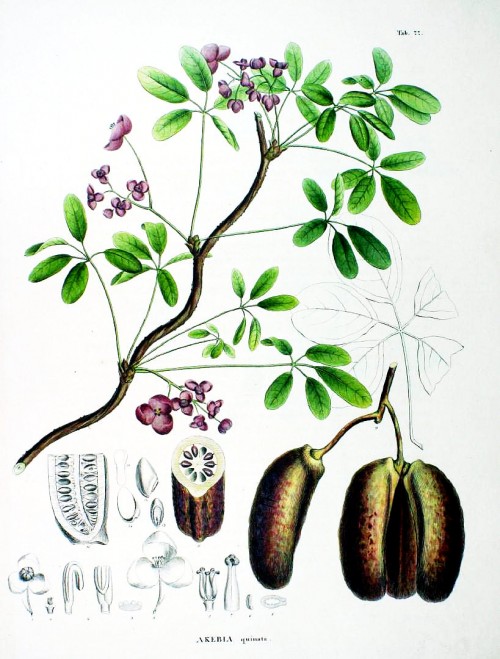Dies ist eine alte Version des Dokuments!
Akebia quinata (Houtt.) Decne. - syn.Rajania quinata Houtt.; Akebia micrantha Nakai. - Lardizabalaceae \ 木通 mu tong (chin.), Akebi (jap.), five-lea akebia, chocolate vine, Fingerblättrige Akebie
Deciduous woody climber, 10m or higher, native to Eastern Asia (China, Korea, Japan), cultivated and naturalized elsewhere; leaves palmate, petiole 4-14cm long, leaflets 4-7cm long, 1-3cm wide, upper side dark green, underside pale green; inflorecences pendulous, 4.5-9cm long; flowers fragrant; male flowers 4-11, with 3 sepals, violet, with 6-7 violet to black stamens; female ones 1-3, dark purple, occasionally green or white, with 3-4 broad elliptic, up to 1.5cm long sepals; fruits purplish, oblong to ellipsoid, 5-8×3-4cm; seeds ovoid-oblong, seed coat brown to black, shiny, pulp white.
„The roots, stems, and fruits are used medicinally.“
http://www.efloras.org/florataxon.aspx?flora_id=2&taxon_id=200008288
„Akebia bark acts diuretic, anti-inflammatory, helps absence of menstruation and during breastfeeding. In addition, the fruit is said to heal cancer and the root to have an antipyretic effect.“
https://de.wikipedia.org/wiki/Fingerbl%C3%A4ttrige_Akebie

Siebold, P.F. von, Zuccarini, J.G., Flora Japonica, t.77 (1875)
http://plantgenera.org/species.php?id_species=35439
